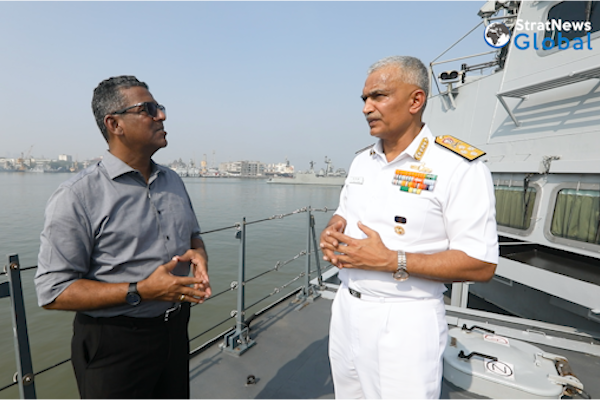MUMBAI: As the Indo-Pacific emerges as the latest domain of great power competition and a belligerent China tries salami slicing in the South China Sea, the Indian Navy has its job cut out.
We try to generate collective maritime competence in the region, says Navy Chief R Hari Kumar. And that comes through multiple thrust areas or TIDES (Trust, Interoperability, Domain awareness, Engagement and Security). “We engage with navies and coast guards of friendly neighbouring countries, help them with capability development, capacity building and training; trust cannot happen overnight; we have to develop it over a period of time,” the Admiral told StratNews Global Editor-in-Chief Nitin A. Gokhale in an exclusive interview on board INS Visakhapatnam.
The engagement stems from respecting and giving the partner the same place at the table, irrespective of the size of its navy or coast guard, “because everybody can bring something or the other to the table”.
China’s Maritime Aggression
Asked about Chinese aggressive behaviour in the South China Sea, Admiral Hari Kumar said given the disputed claims in the area, the answer is to stick to a rules-based order. Despite being a signatory to UNCLOS ((United Nations Convention on the Law of the Sea), China barely abides by global maritime rules. In 2016, it rejected an international tribunal’s ruling that went in favour of the Philippines, rejecting China’s territorial claims. “If you go for arbitration and the arbitrator gives a decision, you need to stick to it. You cannot say, if it’s not in my favour, I won’t abide by it.”
Need For Another Aircraft Carrier
IOR, the Indian Navy’s primary sphere of operation, is vast. Indo-Pacific makes it even wider. That explains Admiral Hari Kumar’s pitch for another aircraft carrier, the second one (after INS Vikrant) that can be indigenously built. “There has always been a felt need for three aircraft carriers. China is building 10; other countries too have adequate numbers. The idea is to have at least two operational carrier battle groups, for which we need three aircraft carriers.”
According to him, the third carrier can be about the size of the second one but with more firepower. “We must tap the expertise that is available, the capability that’s there to build (an aircraft carrier). Secondly, this is the age of drones and niche technologies. So why not look at unmanned aircraft to team with manned aircraft so that we may be able to generate a similar type of capability as that of a bigger aircraft carrier?”
Coastal Security
A decade and a half after the Mumbai terror attacks that exposed holes in India’s maritime surveillance and security, some corrective measures have been taken. Both the Navy and the Coast Guard have been strengthened for coastal security purposes; coastal radar chains are in place and so are coastal patrol vessels; manpower has been augmented and there’s better networking with coastal police stations, the Admiral said. But “security can’t be foolproof; it’s best to remain alert”.
Related Content:





